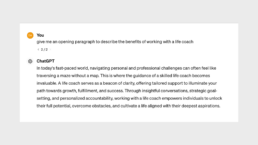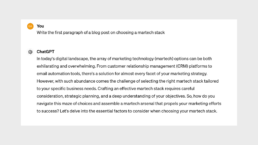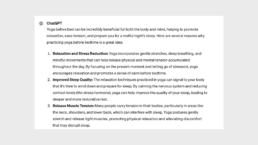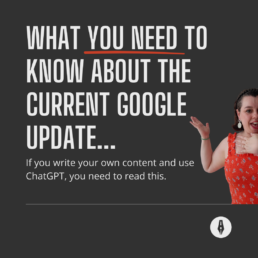
Is your AI content safe to use?
Use these 12 pointers as a checklist to identify AI-written content.
AI is everywhere. We can’t avoid it and we don’t really know what lies ahead, so anyone who tells you differently is trying to sell you something.
I’m not going to whinge about it. I know it has its uses. But when I hear businesses talk about how easy it is to create X, Y and Z, from nothing, inside my head I’m screaming. There are some really great AI tools out there— sophisticated, well-designed and built. But for the average small business, it’s the attraction of tools like ChatGPT that has me worried.
Maybe you think it’s an amazing addition to your business because you can create content at speed and scale. BUT, if you rely too heavily on it, you’ll be producing really crap copy that turns people off, not to mention you can be penalised for incorrect usage of AI if it leads to spam content.
Here’s the current state of play.
- Google hasn’t and is unlikely to ban AI content. Because not all use of automation is bad. It’s been used for a long time to generate things like the weather forecast, sports results and transcription. It’s also now evolved so much that it can be used to help in many processes, including creative ones.
- However you’re producing content, (totally with AI, totally manual or a mix of both), what Google looks for is original, high-quality, people-first content demonstrating the qualities of E-E-A-T.
- E-E-A-T stands for Experience, Expertise, Authoritativeness and Trustworthiness. Trust is the most important quality here and the others contribute to it. Each piece of content you produce might hit one, some or all of these qualities.
- What many people are now using AI for, is to produce large amounts of unoriginal content that provides little to no value to users, with the primary purpose of manipulating ranking in search results. THIS! my friends, is what is a violation of Google’s spam policies as it is classed as ‘scaled content abuse’ – that is, many pages created for the primary purpose of manipulating search rankings and not helping users.
Why evaluate for possible AI content?

Checking to see if your own content or someone else’s has used AI and leaned too heavily into it can help keep your content original, unique, more interesting and more trustworthy. It can help you to avoid the pitfalls of sounding robotic and trotting out the same as others. Just remember, that while there are indicators of AI usage, you’ll never really know the truth unless you ask the person who posted the content or if you’ve done it yourself, you’ll obviously know the truth.
How to manually evaluate your content to detect AI writing.
While there are some paid and free online tools you can use to spot AI content, these can sometimes create false positives. It’s best to use a combination of both these tools and manual checks.
Here are all the manual efforts you can make. Use this like a checklist.
1. Repetition in AI content
ChatGPT and other AI writing tools repeat phrases and ideas. They often do so at a surface level, without explaining the depth of something and they lack the human ability to recognize they are essentially saying the same thing over and over.
To identify AI-generated content, look out for this repetition. A good, human copy or content writer would be able to share ideas in fewer words and expand on those ideas to give more depth rather than repeating the main topline phrases or topic.
2. Robotic Sentence structures
AI relies heavily on common idioms and phrases, often using them to excess and in the wrong way. If you see a lack of variation in sentence structure then you could be looking at AI content. The tone might feel very formal and monotonous and the sentences technical, rigid and unnatural. Look for turns of phrase and ways of opening and closing sentences that humans would rarely use, but might seem grammatically correct.
Examples of sentence starters, finishers and phrases commonly used by AI include:
In this ever-changing digital landscape…
In this blog post we’ll discuss…
It’s important to note…
In conclusion…
In the realm of…
Let’s delve into…
3. Overuse of common AI content words
One of the dead giveaways of AI content is the overuse of certain words. These didn’t start out being ‘AI’ words. They weren’t created by AI, but we’re now at a point where these words can’t be used without it signalling heavily that your content might be AI generated. I don’t advocate cutting these out of your written vocabulary altogether, because there may be times when it’s appropriate to use them, but be very mindful of when and how.
Words to watch out for include:
- Crucial
- Elevate
- Leverage
- Tapestry
- Embark
- Journey
- Foster
- Navigate
- Transform
- Delve
- Furthermore
I asked ChatGPT 3.5 to come up with opening paragraphs for life coaching benefits and how a business might choose a martech stack. These are two common topics in the coaching and SaaS spaces respectively.


Both examples use words we’ve identified as common to AI content. They have a flowery overuse of unnecessary words.
If you were talking to a colleague about martech, would you use the phrase “with such abundance comes the challenge of selecting the right martech stack?” Or if you were explaining on a call with a potential client about the benefits of coaching, would you hook them in with “in today’s fast-paced world, navigating personal and professional challenges can often feel like traversing without a map.” No and no. Right?
4. Inaccuracy of AI content
ChatGPT 3 does not have the ability to read live data. That means if you paste in a URL and ask it to look at the copy on that page and write something similar, it won’t be able to because it can’t look at that live URL. It won’t be looking at the most recent information available.
It also has a disclaimer on its site that says, “ChatGPT can make mistakes. Consider checking important information.” Don’t just consider. Do it. Especially if you deal in anything related to the emotional, physical or financial wellbeing of your audience. Misleading or inaccurate statements can lead to more than just losing a potential customer. You have a duty as a business owner to act responsibly.
5. Robotic tone of voice
AI content generally lacks the human traits that make each of us sound like us. They don’t use unique tones of voice, colloquialisms, slang or informal language. And therefore end up sounding monotonous, boring and dry.
6. Lacks depth
AI content tends to lack depth because there is no lived experiences to share or real-life examples. Humans tend to add these things in to help explain or prove a point.
AI content uses lots of filler and fluff words that don’t add value, so the copy can sound complex and important, but not actually have any substance. If you’re creating content for your blog (and there are so many reasons to be blogging for your business) you really want to be producing articles that aren’t a waste of time for your reader.
Here is just part of what ChatGPT told me about yoga before bedtime.

It’s all a bit vague. (There were several more numbered points). The AI content doesn’t tell me how to do any of the poses or explain exactly how the nervous system calms down. So now if I want to know more, I have to go and research it myself. It’s not really giving me anything of value.
7. Mismatched search intent
Google is pretty sophisticated. If you type in a search query, it will also assume the intent behind that query to help show you the right results. For example, if you type in “red shoes” it knows that most people are going to be looking to buy red shoes so it will show you the shopping feed first. If you type red shoes into ChatGPT you get several points on why you might want to wear red shoes – attention-grabbing, confidence booster etc.

AI content tools can’t always figure out the nuances of search queries. So if content doesn’t match the search intent behind the topic, it may have been produced by AI.
8. Lack of expertise in AI content
Expertise is one of the guiding principles from Google of creating quality content. (E-E-A-T, Experience, Expertise, Authoritativeness and Trustworthiness.) Expertise helps to give meaning, context and understanding, which AI content can’t replicate. AI tools don’t actually understand what they’re writing.
This is why complex topics often sound superficial when written about by AI, because they can’t give the first-hand knowledge that comes from being an expert in a subject matter.

This example on how to make a bed sounds like the writer has never made or slept in a bed before. It even clarifies arranging the pillows at the head of the bed, (maybe in case we end up sleeping upside down?) Generic information like this that can be found with a simple web search is likely to have come through AI.
9. Old content
As mentioned before, some AI tools do not have access to the latest data and most don’t take the relevance of that into account. So they wouldn’t know to prioritise a more recent statistic for example. They can’t update their knowledge base in real time.
Always check the sources and whether the information in your AI generated content is still relevant and recent.
10. No flow
Good writers can create a flow. A narrative that helps the reader digest the information. AI generators struggle with this so it may seem like they jilt the reader about. The content may lack a natural progression and story coming across as disjointed and difficult to follow.
11. Difficulty with humour, sarcasm and emotion
AI writers may struggle with cultural and geographical nuances, humour, social cues, or historical contexts and emotions that help give stories their depth and meaning.
Sentences may seem jarring as AI attempts to inject humour, an exclamation mark to force emotion or not be able to understand a sarcastic tone from a serious one.
Imagine the unfunny comedian whose stand up routine falls flat in front of an audience. Imagine that level of cringe in a blog post you get AI to write for you about something that’s actually quite serious but you wanted to add a couple of humorous points to so that the tone was light. I feel queasy thinking about it!
AI doesn’t have any emotional intelligence or intuition.
Human writing is more subtle and humour tends to be context-appropriate.
12. AI detector tools
There are lots of AI writing detectors out there. Copyleaks is my favourite. Some will also check for plagiarism. And while they can be helpful, they’re not perfect. They analyse using style, tone, words and phrases that merely signal AI content. They can and often have, flagged content as AI when it was human written. So use with caution alongside the other manual checks here.
Should you disclose when you’ve used AI content?
Google says there’s no rule for this at the moment, but bear in mind that this could change as AI progresses.
The best way to avoid any AI penalties
Hire a copywriter! If you’re unsure about AI content or you find it doesn’t pass the checks listed here, you might want to consider hiring someone who writes this stuff all day long.
If want your copy to be of high quality, SEO-friendly, to sound like you, be safe to use and above all to be helpful for your audience, the best way is to hire a copy or content writer to do this for you.. You’ll know for sure that you are building an authentic and genuine relationship with your audience when you hire a professional.
Tell me about your copy challenges and I’ll help you figure out that next step.
April 16, 2024
10 Reasons you should be blogging for your business
September 4, 2024
799 Spam Words To Avoid
September 6, 2024
Do I need a website? A guide for online businesses in 2025
March 22, 2024





